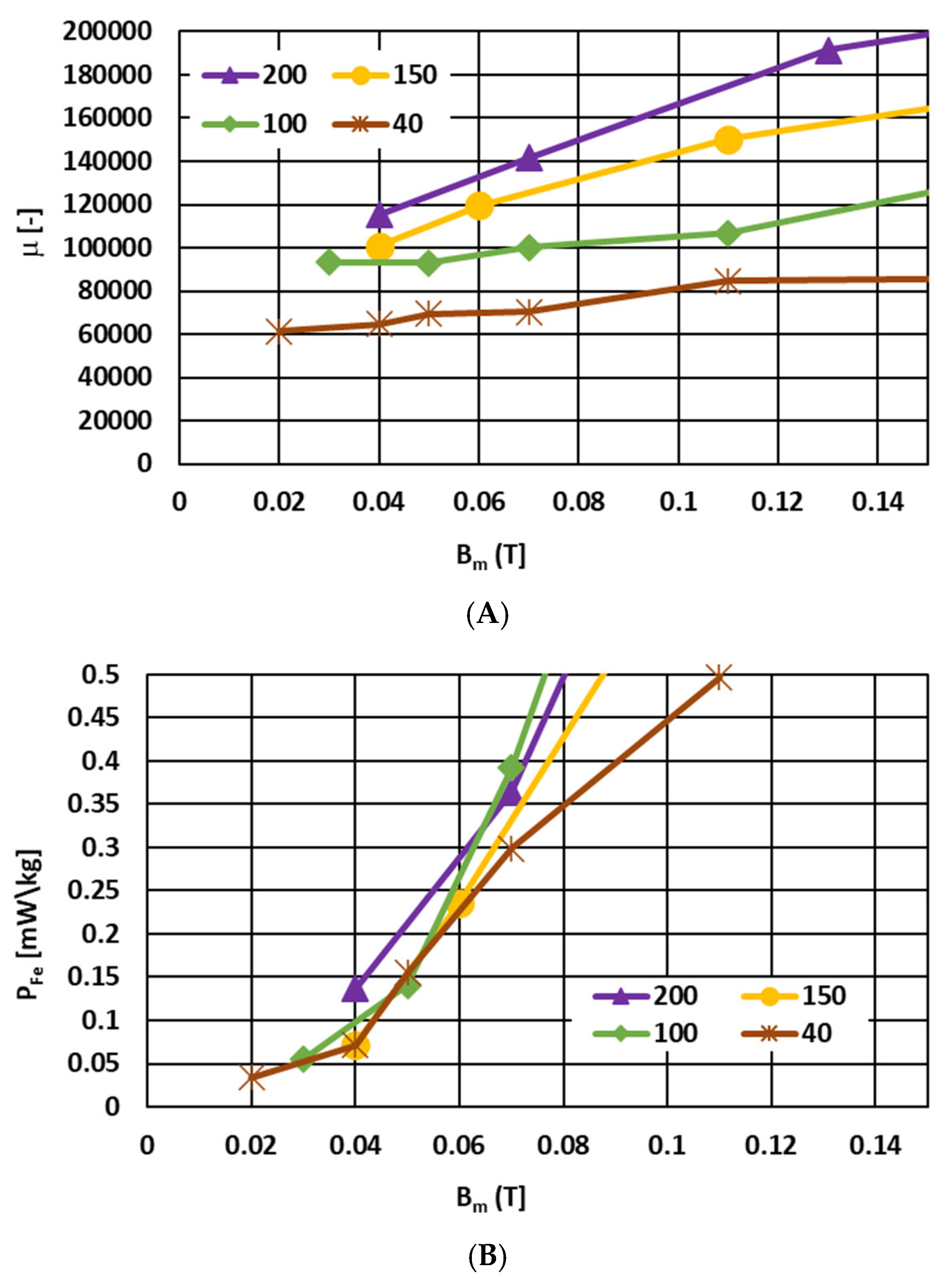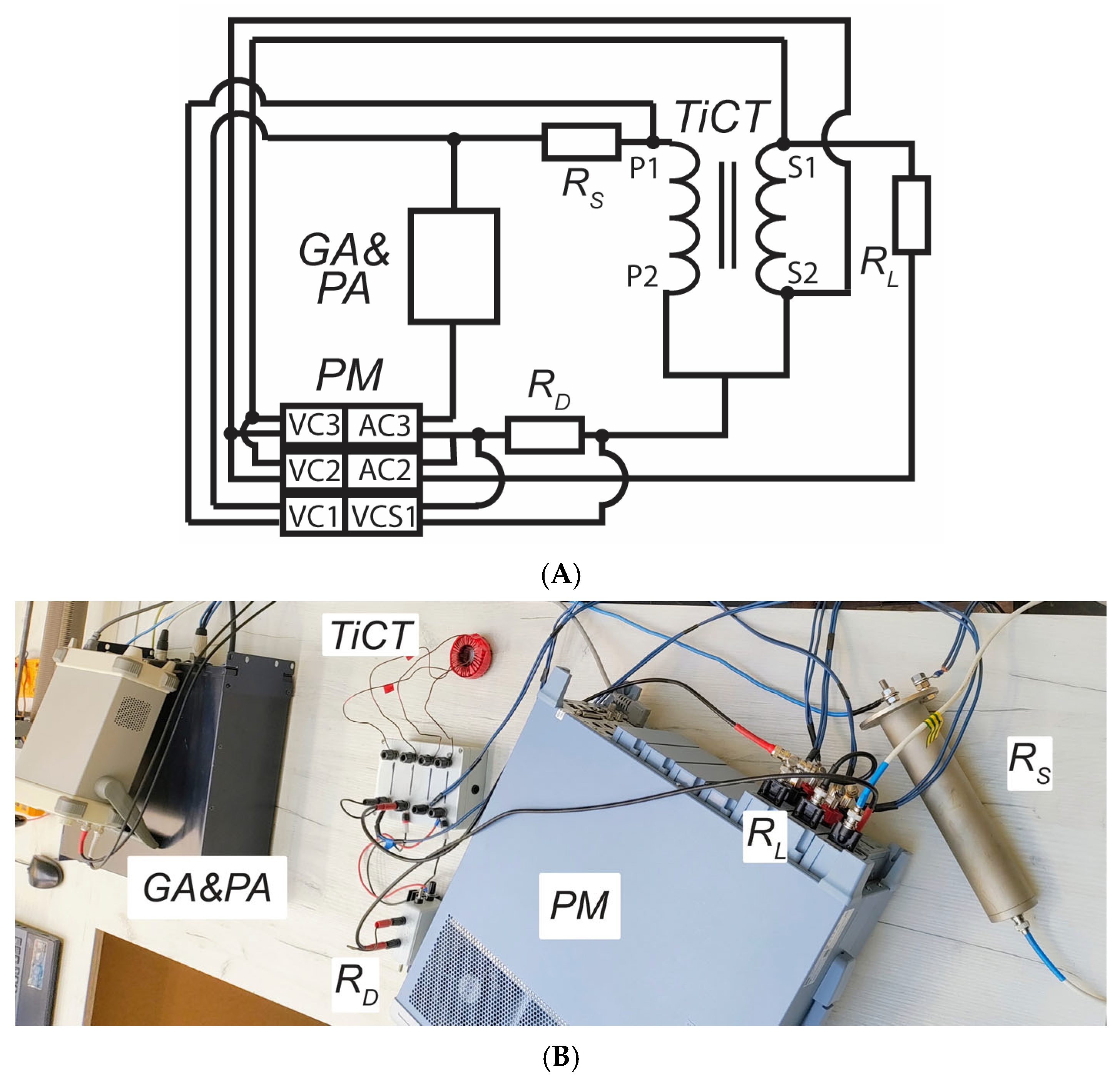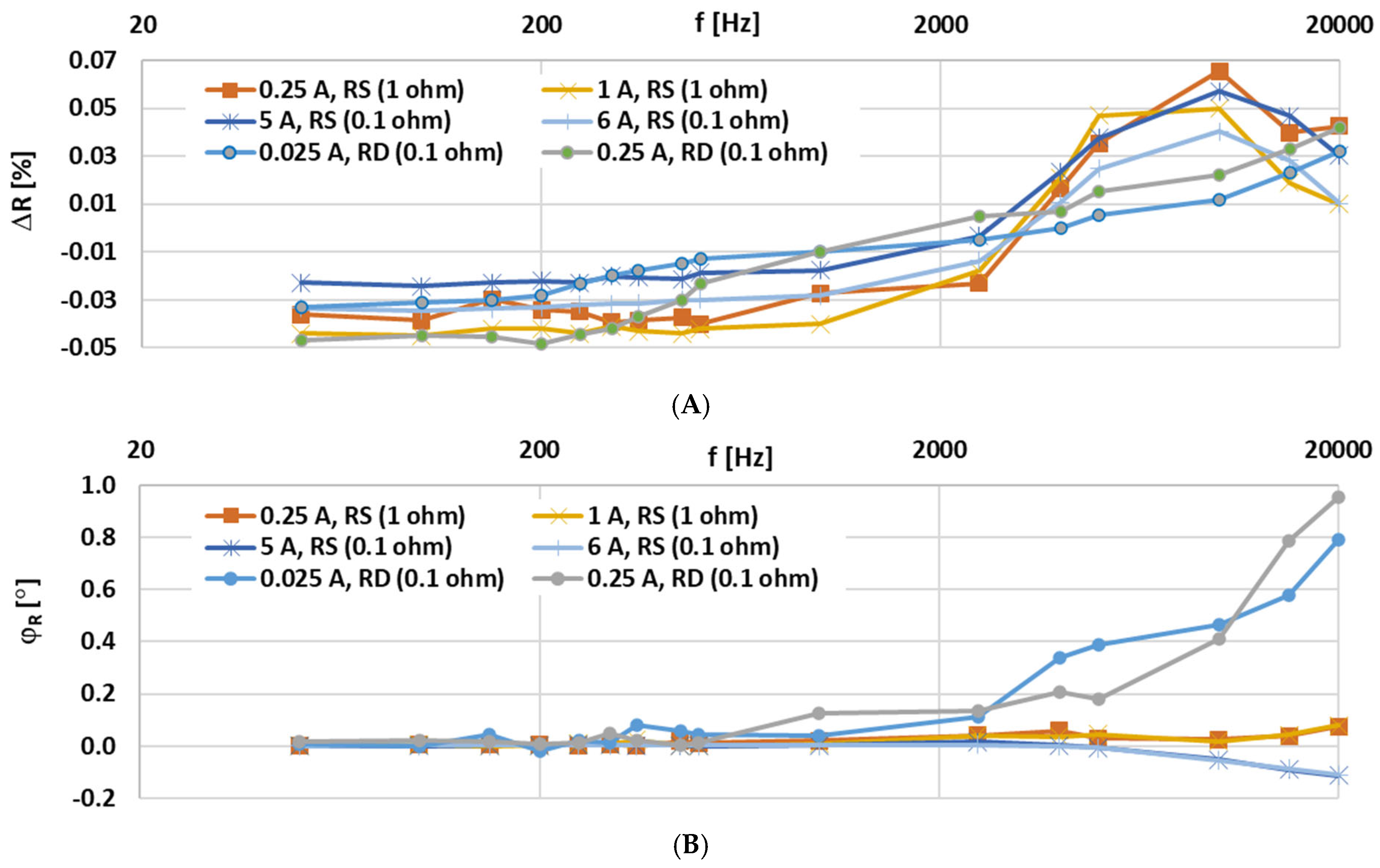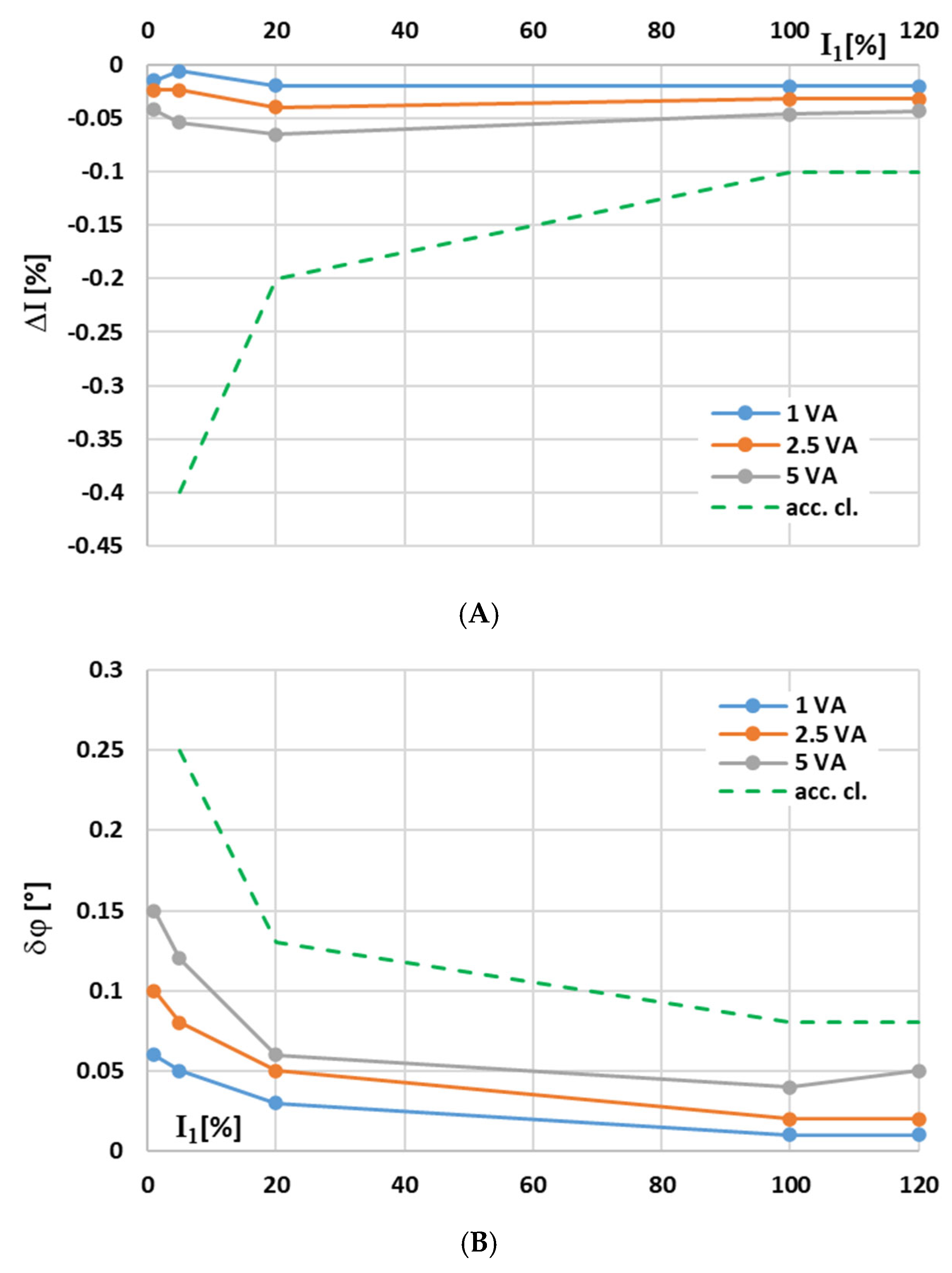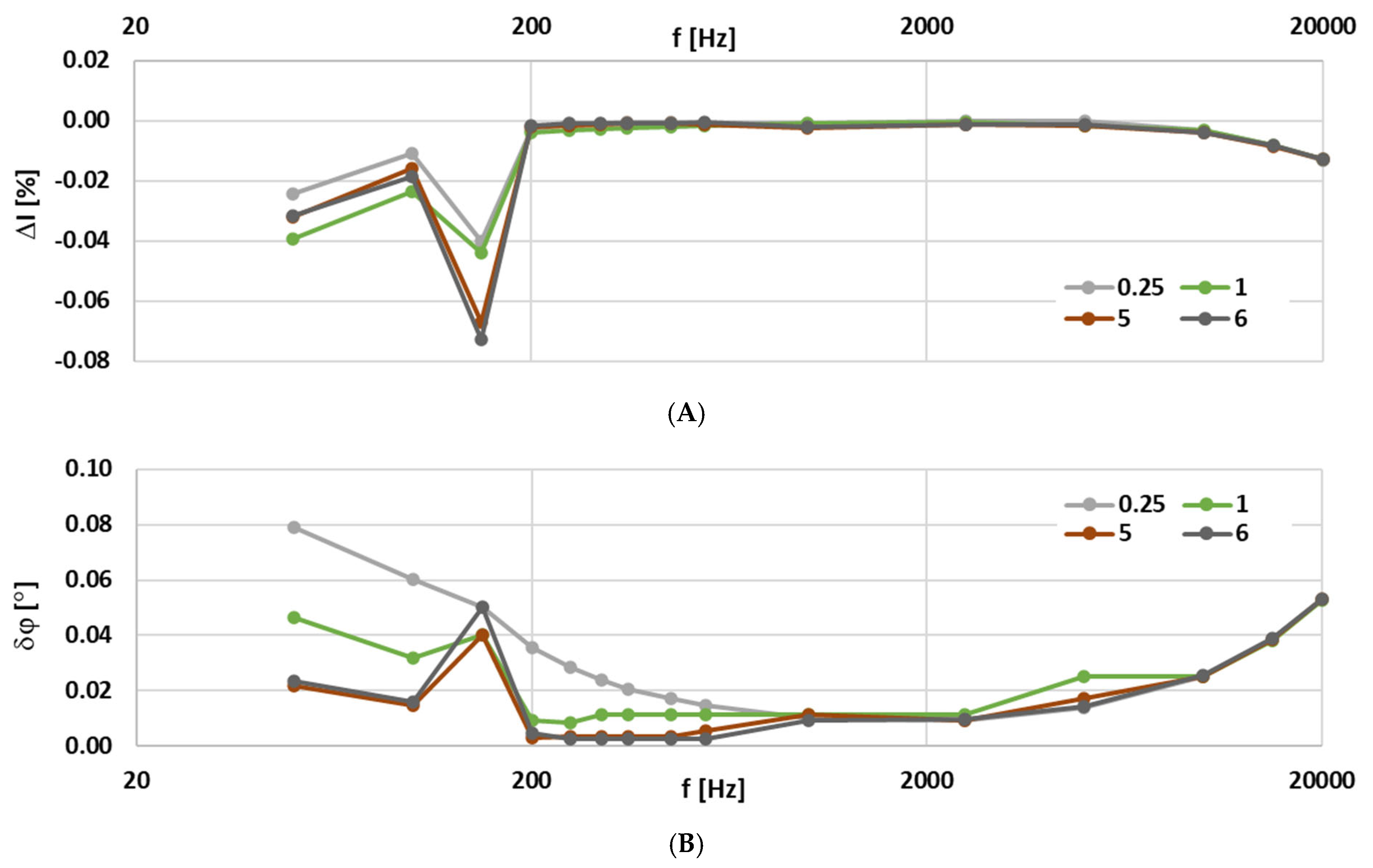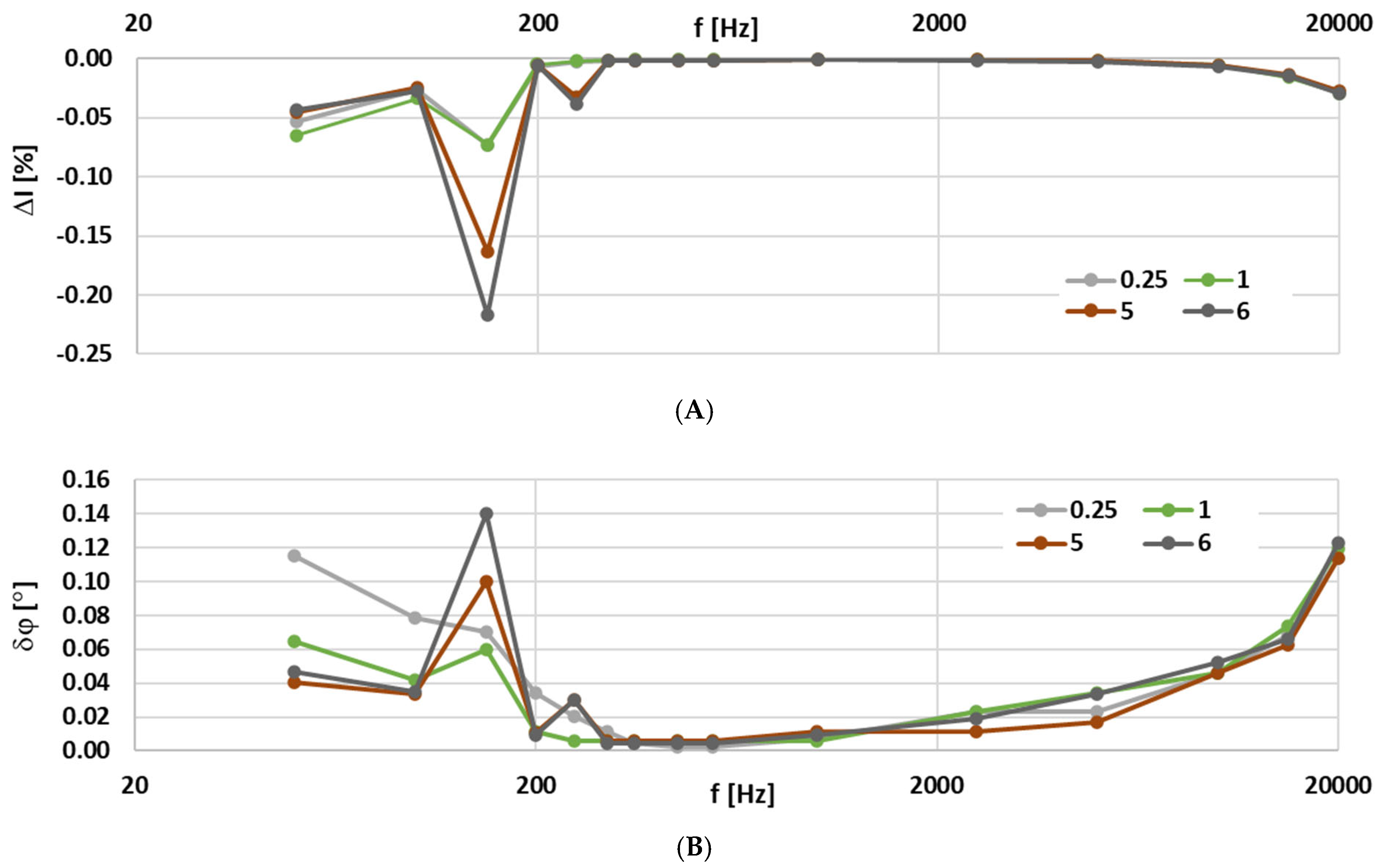1. Introduction
The newest release of the standard IEC 61869-1 introduces optional wideband accuracy classes for inductive instrument transformers (IT) and the transformation of higher harmonics and sinusoidal signals [
1]. This was the response, inter alia, for boosting inverter efficiency by optimizing them to operate at higher switching frequencies. This created a need to explore the impact of harmonics on the power grid at higher frequencies than typically analyzed for power quality, with limitation up to the 2–3 kHz range [
2,
3,
4,
5,
6,
7]. Therefore, wideband accuracy of IT and the evaluation of conducted distortions in voltage, and especially current at the extended frequency range, became important to ensure electrical networks operate reliably and efficiently. In the standard IEC 61869-1, the following accuracy class extensions are defined: WB0, covering the frequency range of higher harmonics up to the order of 13th; WB1, for frequencies up to 3 kHz; WB2 for up to 20 kHz; WB3 for up to 150 kHz; and WB4 for frequencies up to 500 kHz [
1]. Taking into consideration these outlines, the accuracy class of the wideband IT can be indicated as follows: 0.1-WB2. In this case, the inductive voltage transformer (iVT) or inductive current transformer (iCT) declares that the accuracy class is 0.1 for the transformation of sinusoidal voltage or current of rated frequency 50 Hz/60 Hz, while its wideband accuracy class is WB2. Therefore, the values of the ratio error and phase displacement should not exceed ±1%/°, encompassing the range of frequencies above 50 Hz/60 Hz up to 5 kHz ±2%/°, and 10 kHz ±5%/° above this frequency up to 20 kHz. It was accepted in the standard IEC 61869-1 that the test for distorted current or voltage must be carried out using the rated primary signal at the rated frequency with the addition of a percentage of the rated primary signal at each tested harmonic frequency [
1]. In the literature covering this scientific problem concerning the evaluation of inductive IT for the transformation of distorted signals, there are presented necessary measurement systems [
8,
9,
10,
11,
12,
13]. Due to the nonlinearity of the magnetization characteristic of their magnetic core, it is important to ensure rated test conditions concerning mainly the magnetic flux density in the magnetic core are as they are during their normal/typical operation in the power grid [
13,
14,
15,
16]. This applies to the rated value of the primary current and the rated value of the secondary winding load. In the case of the window/through-hole iCTs, the conditions corresponding to the rated primary current may be ensured by the rated ampere-turns [
13]. In the case of the bar/wound iCTs, the appropriate step-up current transformer and wideband power amplifier with arbitrary control generator or programmable power source are required [
17,
18]. Two main types of measuring concept are used: comparative measurements between two channels, or differential measurements. In the first idea, the secondary currents or voltages of the reference source and the tested IT are compared [
8,
9,
17]. In principle, both can even have different rated values of primary and secondary currents. In the second solution, the differential circuit is prepared and the differential current between the secondary winding of the tested iCT and the secondary winding of the reference CT is measured. In this method, the secondary current of the reference current transformer ought to be also measured. In this case, the rated values of the secondary currents of referenced and tested CTs are required to be the same. Both mentioned types of measuring concept may be used for testing the window/through-hole type iCTs in the rated ampere-turns method. In this scenario, additional winding has to be made. Its number of turns must be equal to the rated number of turns of the secondary winding resulting from the rated primary current and the rated transformation ratio of the tested CT. Then, the differential current between the secondary winding of the tested iCT and its additional supplying winding is measured [
13].
Nanocrystalline (Nano) materials offer the potential to enhance the wideband performance of inductive current transformers, making it possible to maintain accurate transformation for both distorted and sinusoidal currents ranging from 50 Hz to 20 kHz. This is due to the fact that they ensure superior magnetic properties, such as high initial magnetic permeability and low core loss for 50 Hz and higher frequencies, even beyond 20 kHz [
13,
19,
20,
21,
22,
23,
24,
25]. A silicon steel (SiFe) magnetic core requires a magnetic field strength of around 8 A/m at 50 Hz to reach the maximum value of magnetic flux density, 0.2 T, while the Nano core only needs about 0.8 A/m. Taking into consideration initial relative magnetic permeability, a SiFe magnetic core may reach about 5000, while a Nano core may reach 200,000. As a result, the inductive CT is characterized by higher transformation accuracy due to the lower value of the excitation current at the same operational point, resulting from the secondary winding load at a given primary current. The main emphasis and design difficulties in ensuring high transformation accuracy of inductive CT still concern the lowest frequency of required wideband operation and the fundamental component [
14]. This results from the fact that the secondary voltage (secondary winding impedance and current value) determines the maximum magnetic flux density in the magnetic core. However, its value is reduced by increased frequency of the primary/secondary current [
13]. Therefore, the transformation accuracy of the inductive CT will improve with an increase in the frequency of transformed primary current, as long as the decrease in the initial magnetic permeability and the active power it loses at the same time is lower. In the frequency range from 50 Hz to 20 kHz, there may be a reduction of up to 50% of initial relative magnetic permeability and an increase in active power losses of up to 5 times the starting loss rate. However, it should be noted that these values are determined for the same value of the maximum magnetic flux density in the magnetic core, while the increase in frequency would require a proportional increase in the maximum value of secondary voltage. Moreover, to ensure the highest transformation accuracy for the main component of distorted current and wideband operation of an inductive CT, it is crucial to minimize the self-distortion of the secondary current by keeping the load of the secondary winding as low as possible by reducing to minimum connected impedance. The authors of [
13] present an analysis of how the shape of a hysteresis loop affects the distortion of the magnetizing current (and consequently the secondary current) depending on the operating point of the inductive CT on the magnetization characteristic.
This study is devoted to discussing the requirements for compliance of the developed wideband inductive current transformer (iCT) with the standard IEC 61869 WB2 class extension for frequencies up to 20 kHz, and the highest accuracy class 0.1 is defined for inductive CTs. Relevant procedures and required measuring systems are proposed for the evaluation of its transformation accuracy and the monitoring of all necessary conditions during the test. The limitation of the secondary winding load power of the inductive CT is proposed in order to ensure its highest possible wideband transformation accuracy and lowest possible self-distortion of secondary current. Therefore, the low-power inductive CT should be designed and used for measurements in the power grid, as they will ensure the highest wideband transformation accuracy. Improved performance of the used power meter/analyzer enabled the possibility to extend the tested frequency range of inductive CT under investigation up to 20 kHz. Meanwhile, the application of nanocrystalline magnetic material for its magnetic core provided the opportunity to minimize its size and weight in order to obtain its compact design in a simple, cost-effective, and long-term reliable solution. Moreover, the design of the iCT is discussed, and its high wideband accuracy for transformation of distorted and sinusoidal current is demonstrated for the real operating conditions. This study also discusses the evaluation of the increase in the load impedance of the secondary winding due to the increase in its reactance with frequency, as the influence of inductance of connection wires may not be ignored for the required frequency range of operation up to 20 kHz. It has been demonstrated that the main emphasis and design difficulties in ensuring high transformation accuracy still concern the lowest frequency and the fundamental component. Therefore, detailed analysis concerning transformation accuracy of the developed iCT for 50 Hz sinusoidal current and the frequency of the main component of distorted current are presented. Moreover, the wideband performance of essential components of the used measuring system such as current sense resistors, including the change in their current-to-voltage conversion ratio and phase shift between voltage and current, are presented. It is shown that the highest accuracy performance is obtained for low average length of the magnetic flux path in the magnetic core—a small window diameter of the magnetic core, low rated apparent power of iCT, high relative magnetic permeability and rated primary current, as well as an oversized cross section of the magnetic core. An increase in the primary current frequency, as long as the relative magnetic permeability does not decrease and the active power losses in the magnetic core do not increase, helps to ensure higher transformation accuracy of iCT.
2. Design Requirements in Order to Develop High Accuracy 0.1-WB2 Inductive CT
In the equivalent circuit of the iCT, the primary winding resistance and leakage inductance are disregarded, as they do not impact its performance. This is because the primary current is not affected by these parameters. The secondary current can be calculated using the following equation, as the magnetic core’s excitation current must be considered:
where
—instantaneous value of the primary current converted to the secondary side of iCT;
—instantaneous value of the secondary current;
—instantaneous value of the magnetic core’s excitation current converted to the secondary side of iCT.
Equation (1) shows that the transformation errors in iCT arise from the presence of the magnetic core. Its transformation accuracy is better when the excitation current is small. Therefore, the most significant condition that affects its performance is the maximum value of the magnetic flux density in the magnetic core, expressed by the following equation:
where
Bm—maximum value of the magnetic flux density in the magnetic core [T];
z2—number of turns of the secondary winding of iCT [-];
sFe—cross section of the magnetic core [mm2];
u2—instantaneous value of the secondary voltage of iCT [V].
Equation (2) shows that the excitation current of the magnetic core is dependent on the maximum value of secondary voltage that results from the value of the secondary current and load impedance of the iCT’s secondary winding. Moreover, the increase in the secondary winding load causes an increase in the secondary voltage and an increase in the magnetic flux density in the magnetic core. Therefore, its excitation current will also increase. To obtain the best performance, the rated apparent power of the inductive CT should be limited, and the solution is to develop the low-power iCT.
Figure 1 shows the changes in the 50 Hz magnetic flux density of relative magnetic permeability (A) and active power losses (B) of the four physically identical toroidal magnetic cores made from nanocrystalline material with different maximum values of the relative magnetic permeability (40,000, 100,000, 150,000, and 200,000).
The results from
Figure 1 indicate that for the construction of the wideband iCT, the magnetic core made of the nanocrystalline material with the maximum value of the relative magnetic permeability, 150,000, should be chosen. It is characterized by smaller active power losses than the 200,000 type.
The transformation accuracy of iCT may be estimated from the following equation:
where
S2—rated apparent power of iCT [VA];
lFe—average length of the magnetic flux path in the magnetic core [mm];
f—frequency of the primary current [Hz];
I1—rms value of rated primary current [A];
z1—number of turns of the primary winding of iCT [-] (in the window/through-hole type iCTs this parameter is equal to 1) [-];
μ—relative magnetic permeability [-];
μ0—magnetic permeability of vacuum (4π × 10−7 [H/m]).
Equation (3) shows that the best accuracy performance is obtained for low average length of the magnetic flux path in the magnetic core, a small window diameter of the magnetic core, low rated apparent power of iCT, high relative magnetic permeability and rated primary current, as well as an oversized cross section of the magnetic core. An increase in the primary current frequency, as long as the relative magnetic permeability does not decrease and the active power losses in the magnetic core do not increase, helps to ensure higher transformation accuracy of iCT. The chosen type of nanocrystalline magnetic core provides the initial 100,000 relative magnetic permeability. Consequently, the designed iCT will ensure higher transformation accuracy due to the lower excitation current required at the same operational point (which results from the secondary voltage). The challenge in achieving high wideband transformation accuracy of iCT still revolves around the low frequency required for its operation. This is because the decrease in the initial magnetic permeability is only of about factor 2, but with a 400 times increase in the primary current frequency up to 20 kHz [
13]. This is not only provided by the magnetic core properties, but also is a result of decreasing magnetic flux density in the magnetic core proportional to the increase in the frequency of the iCT’s secondary voltage/primary current. At the same time, in the frequency range of 50 Hz to 20 kHz, the active power losses can increase by as much as five times. In order to ensure the highest transformation accuracy of iCT for the fundamental component of a distorted current and enable its wideband operation, it is essential to minimize the self-distortion of the secondary current. It is also important to consider, in this aspect, the temperature of the magnetic core [
26]. This can be accomplished by keeping the secondary winding load as low as possible, reducing the connected impedance to a minimum. Therefore, an iCT is developed with the following dimensions: D65 × d30 × h25 mm (external diameter of iCT × its internal window diameter for the primary conductor × diameter of its thickness). A current density of 2.5 A/mm
2 was chosen to determine the diameter of the copper wire as 1.6 mm for the secondary winding, with rated current equal to 5 A. For the designed window-type iCT, with the rated primary current of 250 A, 50 turns are required.
3. Evaluation Method of Wideband Transformation Accuracy and Used Measuring Setup
The wideband transformation accuracy of the developed iCT was tested in the rated ampere-turns conditions. Therefore, an additional primary winding with 50 turns and rated current equal to 5 A was implemented. The measuring system was powered by an arbitrary power source comprising an audio power amplifier and an arbitrary waveform generator [
18]. This setup enabled the generation of distorted currents with programmable harmonics content, covering the required frequency range from 50 Hz to 20 kHz, with adjustable phase angles of higher harmonics relative to the fundamental component. When the RMS value of the distorted primary current in the additional primary winding was set to 5 A RMS and the winding consisted of 50 turns, it ensured conditions equivalent to 250 A RMS.
In
Figure 2, the measuring setup used to test the wideband accuracy of the developed wideband iCT is presented.
In
Figure 2A,B the following notations are used:
GA&PA—arbitrary waveform generator and audio power amplifier,
TiCT—tested iCT,
PM—digital power meter WT 5000,
RD—0.1 Ω current shunt for measurements of differential current,
RS—0.05 Ω (for 5 A and 6 A)/1 Ω (for 0.25 A and 1 A) current shunt chosen based on the RMS value of the current required to be measured in the additional primary winding,
RL—0.2 Ω (5 W)/0.1 Ω (2.5 W) load resistors or PM current module connected to the secondary winding of the iCT during the accuracy test.
The value of the current error for transformation of a given harmonic of distorted current by the tested iCT is determined on the basis of two voltages measured by the single modules of the PM. The differential current is measured by the current shunt RD, and the primary current in the additional primary winding is measured by the current shunt RS. The PM module is configurated to measure voltage from current sense input instead of direct measurement of current by the internal current shunt.
The RMS value of the k-order distorted current harmonic in the additional primary winding of the tested iCT was determined using the following equation:
where
RS—resistance of current shunt RS [Ω],
UShk—RMS value of the k-order distorted voltage harmonic from current shunt RS [V].
The value of the composite error for transformation of the k-order distorted current harmonic by the tested iCT was determined using the following equation:
where
RD—resistance of current shunt RD [Ω],
UDhk—RMS value of the k-order distorted voltage harmonic from current shunt RD.
In order to guarantee the required accuracy of the measuring setup, the ratio error and phase shift in voltage in relation to the current of the used current shunts were determined. In
Figure 3, the results of the accuracy tests of the used resistors are shown: (A) the ratio error (conversion error of current-to-voltage from Equation (4)) and (B) the phase shift as the difference between the phase angle of the current and the voltage on the resistor are presented.
The results from
Figure 3 indicate that the ratio error of the used resistors for the current shunt did not exceed ±0.07%, while the phase shift error did not exceed ±1°. Therefore, their accuracy performance has no significant impact on the accuracy of the developed measuring setup for the evaluation of the wideband accuracy of iCT.
In the differential measuring method, the value of the k-order distorted secondary current harmonic is determined from the following equation:
where
The value of the current error for the transformation of the k-order distorted current harmonic by the tested iCT was determined using the following equation:
The value of the phase displacement for the transformation of the k-order distorted current harmonic by the tested iCT was determined using the following equation:
The iCT’s wideband transformation accuracy of distorted and sinusoidal current is demonstrated for the real operating conditions. Therefore, the increase in the load impedance of its secondary winding during the accuracy test due to the increase in its reactance with frequency caused by inductance of connection wires was also evaluated.
In
Figure 4, the increase in the resultant load impedance of the resistors used during the test and the wires being connected to the secondary winding of the iCT is presented, taking into consideration its (A) magnitude and (B) phase difference between voltage and current of the secondary winding.
In the analyzed case, when the secondary winding load power was 0.7 VA, only the current measuring channel of the power meter was connected to the tested iCT, and two 2.5 m wires were used to recreate the real operating conditions. In all conditions, the increase in the load impedance of the secondary winding (due to the increase in its reactance with frequency caused by the inductance of the connection wires) may not be ignored for the required frequency range of operation up to 20 kHz. This has the most important influence on the similar performance in terms of the transformation accuracy of the tested iCT for all 3 load values. This is due to the fact that the magnetic flux density in the magnetic core with an increased frequency of transformed current becomes similar in all tested cases, and is relatively low taking into consideration the 400-fold increase in frequency and proportional decrease in the magnetic flux density, and only a 2 (for 5 VA), 3 (for 2.5 VA), or 12 (for 0.7 VA) times increase in secondary voltage.
4. Results of Accuracy Tests
The accuracy tests of the developed iCT were performed for 5%, 20%, 100%, and 120% of the rated primary current (RMS value equal to 250 A), which is equivalent to 5 A for 50 turns in the additional primary winding. In the beginning, its transformation accuracy for a 50 Hz sinusoidal current was tested in accordance with the standard IEC 61869-2 [
27]. However, the resistive loads 5 VA, 2.5 VA, and 0.7 VA (below the lowest used standard value of 1 VA) of the iCT’s secondary winding were used. In
Figure 5, the determined values of (A) current error and (B) phase displacement are presented.
The result from
Figure 5 indicate that the maximum detected values of the current error did not exceed ±0.1% for 20% of the rated primary current, and phase displacement did not exceed ±0.15° for 5% of the rated primary current, both for a 5 VA load in the tested iCT’s secondary winding. A decrease in the secondary winding load caused an improvement in its transformation accuracy performance, as there were no turn corrections made. In the most optimal conditions—when the secondary winding is 0.7 VA—the detected values of the current error did not exceed ±0.025% (the maximum value was still detected for 20% of the rated primary current) and phase displacement did not exceed ±0.06° (the maximum as wis still detected for 5% of the rated primary current). Irrespective of the secondary winding load, the tested iCT met the requirements of the 0.1 accuracy class in accordance with the standard IEC 61869-2. However, the best linear performance with the change in the primary current RMS value was obtained by the lowest value of its secondary winding load.
In the next stage of laboratory tests, the wideband transformation accuracy of the developed iCT was evaluated for a distorted primary current, with the main frequency equal to 50 Hz and a 10% level of a single higher harmonic with a frequency ranging from 100 Hz (2nd) to 350 Hz (7th). During the tests, their mutual phase angles were adjusted in 15° steps. This frequency range for the distorted current was limited, as there was no detectable difference between the values of the current error and the phase displacement determined for a higher harmonic and the same-frequency sinusoidal current. Therefore, the wideband transformation accuracy of the developed iCT was evaluated for a sinusoidal current with a frequency from 350 Hz up to 20 kHz (10 frequencies have been selected). In
Figure 6, the results of the accuracy test of the developed iCT for the transformation of distorted/high frequency sinusoidal current for 5% (0.25 A in 50 turns of additional primary winding corresponding to 12.5 A), 20% (1 A corresponding to 50 A of primary current in the single primary conductor), 100% (5 A in rated ampere-turn conditions equivalent to 250 A), and 120 (6 A) of rated secondary (primary) current are presented. During this test, the secondary winding load’s apparent power was equal to 0.7 VA (resulting from the current measuring channel of the power meter and two 2.5 m connection wires), and the determined values of (A) current error and (B) phase displacement are shown.
The results from
Figure 6 indicate that the detected values of the current error did not exceed ±0.03% and the value of phase displacement did not exceed ±0.05°. Therefore, the developed wideband iCT meets the requirements of the 0.1-WB2 accuracy class, as the ratio error and phase displacement did not exceed ±1%/° from 100 Hz up to and including 20 kHz in accordance with the requirements of the standard IEC 61869-1. The visible increase in the values of the current error and phase displacement for 150 Hz results from self-distortion of the secondary current by the tested iCT and self-generation of the 3rd higher harmonic into its secondary current, due to the nonlinearity of the magnetization characteristic of its magnetic core [
14].
In
Figure 7, the results of the accuracy test of the developed iCT (the determined values of (A) current error and (B) phase displacement) for the transformation of distorted/high frequency sinusoidal current with the secondary winding load with apparent power 2.5 VA are presented.
The results from
Figure 7 show that the detected values of the current error/phase displacement did not exceed ±0.08%/°. Therefore, the developed wideband iCT still meets the requirements of the 0.1-WB2 accuracy class, as the ratio error and phase displacement did not exceed ±1%/° from 100 Hz up to and including 20 kHz in accordance with the requirements of the standard IEC 61869-1. The visible increase in the values of the current error and phase displacement for 150 Hz due to the self-distortion is significantly higher, and the current error/phase displacement are increased to −0.08%/0.05° in relation to −0.03%/0.025° for the secondary winding load equal to 0.7 VA in the previous test scenario. These values were determined during the accuracy tests when the mutual phase angles between fundamental and higher frequency harmonics of distorted current were adjusted in 15° steps to determine the highest values of current error and phase displacement. It should be noted that both values were determined for different phase angles of higher harmonics.
In
Figure 8, the results of the accuracy test of the developed iCT (the determined values of (A) current error and (B) phase displacement) for the transformation of distorted/high frequency sinusoidal current with the secondary winding load with apparent power 5 VA are presented.
The results from
Figure 8 show that the detected values of the current error did not exceed ±0.25%, while phase displacement did not exceed ±0.15°. Therefore, the developed wideband iCT, even with this burden, still meets the requirements of the 0.1-WB2 accuracy class, as the ratio error and phase displacement did not exceed ±1%/° from 100 Hz up to and including 20 kHz in accordance with the requirements of the standard IEC 61869-1. The visible increase in the values of the current error and phase displacement for 150 Hz, due to the self-distortion, is significantly higher, and the current error/phase displacement were increased to −0.22%/0.15° in relation to −0.03%/0.025° for the secondary winding load equal to 0.7 VA in the previous test scenario. In addition, the self-generation phenomenon became relevant and visible in the case of the 250 Hz harmonic. However, it is more important for the higher values of the transformed current of the rated primary current (100% and 120%). Therefore, the low-power inductive CT should be designed and used for measurements in the power grid, as they ensure the highest wideband transformation accuracy. The results from
Figure 8 also show that the values of phase displacement at a higher frequency for an increased load of the tested iCT’s secondary winding are only slightly increased from 0.03° to 0.12°. Moreover, taking into consideration all results presented in
Figure 6,
Figure 7 and
Figure 8 for the transformation of the high frequency sinusoidal current by the tested iCT from 1 kHz to 20 kHz, it can be observed that the value of the primary current has no significant/detectable influence on the determined values of the current error and phase displacement. Furthermore, the developed iCT is able to ensure wideband transformation accuracy from 50 Hz up to 20 kHz, with values of current error and phase displacement that did not exceed ±0.1%/° when the secondary winding load was limited to 2.5 VA. Therefore, the 0.1 accuracy class for a 50 Hz sinusoid current in accordance with the standard IEC 61869-2 is applicable up to a frequency of 20 kHz.
5. Conclusions
In this paper, a successful design of an inductive current transformer compliant with the IEC 61869 WB2 class extension for harmonic frequency up to 20 kHz and 0.1 accuracy class with the limited load of its secondary winding at 2.5 VA is presented. Through the conducted analyses of the transformation accuracy in a wide frequency range, it is proven that its high performance enables its application in power networks for wideband power quality monitoring and power metering solutions, as well as in measuring systems as a reference source (with the limited load of its secondary winding at 0.7 VA) for testing inductive current transformer compliance, with the optional requirements of the WB2 classes defined in the latest standard IEC 61869-1. This proposition offers an advantage over the electronically enhanced, active current-to-voltage transducers or current transformers by simple, cost-effective, conventional construction, and the resulting typical long-term reliability. Future reduction in the rated RMS value of the secondary current for enhanced accuracy performance and its conversion into voltage by noninductive current shunt is also possible, as well as the application of an analog-to-digital converter for implementation in smart grids. The results also show that the values of the phase displacement at a higher frequency for an increased load of secondary winding in the tested inductive current transformer are only slightly increased from 0.03° to 0.12°. Moreover, taking into consideration all results presented in this paper concerning the evaluation of transformation accuracy of the designed inductive current transformer for high frequency sinusoidal current in the range from 1 kHz to 20 kHz, the value of the primary current has no significant/detectable influence on the determined values of the current error and phase displacement. The optimal accuracy performance of the inductive current transformer may be obtained by its proper design, i.e., when the average length of the magnetic flux path in its magnetic core is as short as possible, while ensuring it has the required space for the primary conductor/winding and secondary winding. Simultaneously, the window diameter of its magnetic core is required to be small, its rated apparent power should be low, and the relative magnetic permeability and rated primary current should be high. The cross section of the wideband inductive current transformer should be oversized in order to reduce the problem of self-generation of higher harmonics into its secondary current—additional distortion of the secondary current is due to the nonlinearity of the magnetization characteristic of the magnetic core. An increase in the primary current frequency, while the relative magnetic permeability of the magnetic core remains stable and active power losses do not rise, also contributes to improved transformation accuracy of the inductive current transformer in the limited frequency range of operation.
